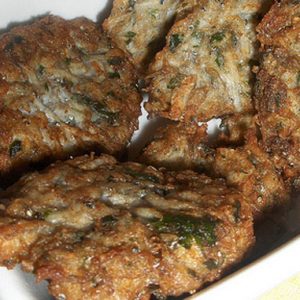
NUNNATA FRITTERS (POLPETTE)
( Polpettine di Bianchetti - Purpetti o Vastidduzzi )
If you are lucky to buy fresh nunnata, make sure it was recently caught; in Brooklyn, where I live, the only nunnata available is frozen and though it is not the same as the fresh nunnata, it is a substitute to prepare some recipes. Frozen nunnata can be boiled and used as a condiment for pasta or can be mixed with eggs, flour, or breadcrumbs, cheese and parsley to prepare fritters, polpettine or vastidduzzi, or served as a delicious snack or as main course.
Nunnata is just born sardines, anchovies or mackerels that can be fished in the Sicilian coastlines for a limited period of time, between February 15 and April 15. Another small fish caught most of the year is the cicireddu, a tasty and small fish that grows to about 3 inches, but when fished from one inch to one and a half inches, it is a fried delicacy served with lemon or a remarkable stuffing to a sandwich; boiled and dressed with olive oil and various herbs and spices, it is a fantastic appetizer.
Cicireddu is caught In the Strait of Messina, where also the russuleddu or russettu (russu means red) small red mullets are fished with strict time limitation; the maggiulini (from maggio, May) are fish similar to cicireddu and are caught in the month of May in many Sicilian shorelines. Nunnata fritters are called in Sicilian dialect purpetti, in Italian polpette; in my family, these delightful goodies are called vastidduzzi. These tasty noshes, delicious warm or cold, are made with nunnata, eggs, parsley, and flour; in my family, the flour is replaced with breadcrumbs to give more texture and taste. You can use either flour or breadcrumbs.
- Serving Size4
- SeafoodNunnata Fritters (Polpette)
Ingredients
- 1 ½ lb nunnata (washed)
2 medium eggs lightly beaten
1 tablespoon finely chopped parsley
2 tablespoons flour or breadcrumbs
¼ cup olive oil for frying, more if needed
Instructions
Against everybody’s recommendation not to wash the nunnata, I advise strongly to delicately wash it to eliminate any residual seaweeds or any sand or foreign articles. Do not wash it in running water, but place the nunnata in a basin with cold water and a little at a time, using your hands, transfer into a strainer to drip. Repeat if necessary.
If using frozen nunnata: defrost overnight in the refrigerator, and wash it, following the above directions.
Place onto a kitchen rag to allow it to dry and refrigerate until ready to use.
In a 6-quarts sauce pot, bring to a boil 4 quarts of water with 1½ teaspoons of sea salt; keep heat to high and add the nunnata, placed in a strainer so as not to disperse in the boiling water. Boil the nunnata for 30 seconds, drain and transfer it into a bowl. Set on the side and refrigerate until ready to use it.
Place the raw or boiled nunnata in a bowl and mix in the eggs and parsley; add the flour or breadcrumbs, salt and pepper to taste. Gently blend the ingredients. The mixture should not be too dry, however if it seems to be too watery add more flour or breadcrumbs.
Place ½ cup of olive oil in a large skillet, over a medium heat; at about 350 degrees, until it shimmers, carefully and smoothly place in the hot oil, tablespoons of the mixture. Cook the fritters on both sides, in few batches; do not overcrowd the pan.
When light golden-brown, with a slotted spoon transfer to drain in a dish covered with paper towels
Serve garnished with wedges of lemon.
